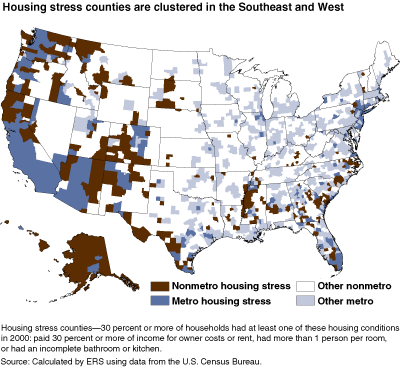One in Four Rural Households are Housing Stressed
- by James Mikesell
- 11/1/2004
Of the Nation’s 2,000-plus nonmetropolitan (nonmetro) counties, 302 are defined as housing stressed, according to ERS’s recently updated county typology. In these counties, at least 30 percent of households failed to meet widely used standards for minimum basic amenities in 2000. This categorization of household-level housing stress requires that one or more of the following conditions be met: (1) housing expense/income threshold—expenses exceed 30 percent of income, (2) crowding—more household members than rooms, (3) incomplete plumbing—home lacked necessary bathroom facilities, and (4) incomplete kitchen—home lacked essential kitchen facilities. This housing stress typology, based on 2000 Census data, can help rural development planners identify counties with the greatest housing assistance needs.
The principal component of housing stress is high housing expenses relative to income, but the other stress conditions also have an impact. In nonmetro housing stress counties, 28 percent of households exceeded the expense/income threshold, while 7 percent of homes were crowded and 2 percent lacked either complete plumbing or kitchens. Such levels on all four conditions are well above those in other nonmetro counties, signifying more severe housing problems.
Compared with other nonmetro counties, housing stress counties are clustered mainly in the Southeast and the West, and have higher proportions of minorities and higher poverty and unemployment rates. They contained 16 percent of all nonmetro households in 2000, but nearly twice that share of all nonmetro Black households (30 percent). An even higher concentration of nonmetro Native American (48 percent) and Hispanic (37 percent) households were found in housing stress counties. The family poverty rate in housing stress counties (15.1 percent) was well above that in other nonmetro counties (10.3 percent), as was the unemployment rate (8.4 percent in housing stress counties, compared with 5.7 percent in other nonmetro counties).
The greater incidence of households with relatively high housing expenses is largely driven by low income and applies to both renters and homeowners in housing stress counties. These counties also have a high share of renters, whose housing costs usually reflect current market conditions. In contrast, homeowners benefit from monthly mortgage payments that are generally unaffected by inflation. Supply constraints do not appear to influence housing expense differences, since vacancy rates for year-round homes in housing stress counties and other nonmetro counties are similar.
The housing stress typology identifies nonmetro counties with a high share of housing problems. But the housing stress definition includes some households whose high housing expenditures reflect a personal choice and not a financial burden, while it excludes others living in cheap low-quality housing. Program responses will be most effective when tailored to the specifics of household and community needs.
This article is drawn from:
- County Typology Codes. (n.d.). U.S. Department of Agriculture, Economic Research Service.


